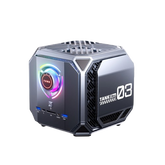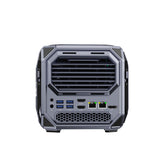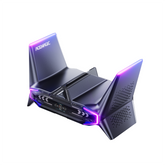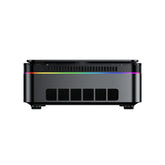eGPU | OCuLink, M.2 NVMe and Thunderbolt: Everything You Need to Know

1. Introduction: Why Do You Need an External GPU (eGPU)?
With the rise of ultra-slim laptops and mini PCs, built-in graphics cards can no longer meet the demands of high-performance gaming, 3D modeling, video editing, and other professional tasks. External GPUs (eGPUs) have emerged as an ideal solution to compensate for this graphical limitation. Among the many interface options available, OCuLink, M.2 NVMe, and Thunderbolt have become the three mainstream connection standards.
2. What Is an External GPU (eGPU)?
An external GPU is a dedicated graphics card housed outside the main computer, connected via a high-speed interface. It’s commonly used by gamers, content creators, and professionals who need more graphical horsepower than their internal hardware can provide.
3. Interface Comparison: OCuLink vs M.2 NVMe vs Thunderbolt
| Interface | Bandwidth | Hot-Swappable | Ease of Use | Compatibility | Cost |
|---|---|---|---|---|---|
| OCuLink | Up to 64 Gbps | ❌ No | 🔧 Medium | Requires a specific port | 💲 Lower |
| M.2 NVMe | Varies (PCIe 3.0/4.0) | ❌ No | 🔧 Low (needs disassembly) | Needs an adapter & BIOS support | 💲💲 Lowest |
| Thunderbolt | 40Gbps | ✅ Yes | ✅ High | Widely supported | 💲💲💲 High |
4. Interface Deep Dive
🔌 What is OCuLink?
OCuLink (Optical Copper Link) is a high-speed external PCIe interface developed by PCI-SIG. Designed to deliver native PCIe 3.0/4.0 performance, OCuLink supports up to 64 Gbps bandwidth with low latency and uncompressed signal transmission.
✅ Pros:
-
Native PCIe connection with direct signal passthrough
-
Low latency and high bandwidth
-
Lower cost than Thunderbolt
❗Cons:
-
No hot-swapping support
-
Requires a compatible OCuLink port on the host device
Recommended Device: Check out the ACEMAGIC AM18 Mini PC, which comes with a built-in OCuLink port for high-end eGPU support and near-desktop performance.
ACEMAGIC AM18 AMD Ryzen™ 7 8845HS Mini PC
🔌 What is M.2 NVMe?
Initially designed for high-speed SSDs, the M.2 NVMe interface also uses PCIe lanes. With an adapter, it can be repurposed to support external GPUs.
✅ Pros:
-
PCIe bandwidth capable (depending on motherboard specs)
-
Great for DIY enthusiasts on a budget
❗Cons:
-
No hot-swap support
-
Stability depends on the motherboard, BIOS, and power design
-
Requires disassembly and careful wiring
Recommended Device: The ACEMAGIC F3A Mini PC with AMD Ryzen AI 9 HX 370 supports M.2 NVMe PCIe 3.0/4.0 SSDs and can be used for eGPU expansion with the right adapter.
ACEMAGIC F3A AI 370 Mini PC
🔌 What is Thunderbolt?
Developed by Intel and Apple, Thunderbolt 3 and 4 provide up to 40 Gbps bandwidth and use a USB-C connector. Widely adopted by laptops and MacBooks, Thunderbolt supports plug-and-play eGPU solutions.
✅ Pros:
-
Supports hot-swapping
-
Broad compatibility and a wide range of eGPU docks are available
-
Plug-and-play convenience
❗Cons:
-
Limited to PCIe 3.0 x4 speeds
-
Data packetization can introduce a slight performance loss
-
Typically more expensive
5. Which Interface Is Right for You?
| User Type | Recommended Interface | Why? |
| Hardcore gamers / Power users | ✅ OCuLink | Delivers best performance, lowest latency |
| DIY builders / Budget upgraders | ✅ M.2 NVMe | High flexibility and value, great for tinkerers |
| Mac / Ultrabook users | ✅ Thunderbolt | Hassle-free setup, hot-swappable, highly compatible |
6. Key Considerations Before Choosing
-
What ports does your device support?
-
Are you comfortable opening your device for upgrades?
-
How much are you willing to invest?
-
Do you need portability and convenience?
7. Conclusion + Call to Action
Choosing the right eGPU interface comes down to your device’s compatibility, your technical comfort level, your performance needs, and your budget.
-
Want desktop-class graphics on a mini PC? Explore the ACEMAGIC AM18 with OCuLink.
-
Want a fun DIY project to upgrade an older device? Check out the ACEMAGIC F3A with M.2 NVMe support.
No matter your choice, understanding your own needs and setup is the first step to unlocking your device’s full graphical potential.
Related Articles:
iGPU vs dGPU vs eGPU: Choosing the Best Graphics Solution in 2025
Understanding Video Cards: Types, Performance & How to Choose
Enhancing ACEMAGIC AMR5 Mini PC Performance with an External GPU









Leave a comment
Please note, comments need to be approved before they are published.